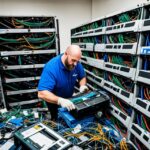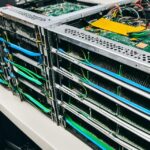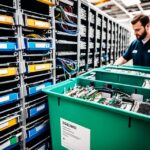The Role of Server Recycling in Enhancing Data Center Sustainability
In the digital age, data centres have become the backbone of our interconnected world, supporting the vast array of online services and applications we rely on daily. However, the environmental impact of data centre infrastructure has become a concern as energy consumption and carbon emissions continue to rise. To address these challenges, sustainability in data centres has gained prominence, prompting industry leaders to reassess their practices. One key aspect of enhancing sustainability in data centres is server recycling, which plays a pivotal role in reducing electronic waste and minimising the environmental impact of data centre operations.
Server recycling not only prevents the accumulation of e-waste but also helps to conserve valuable resources. By responsibly disposing of outdated servers and hardware components, data centre operators contribute to a more circular economy and reduce the need for raw material extraction. This, in turn, helps to mitigate the environmental impact associated with the production and disposal of electronic devices.
Furthermore, server recycling supports the principles of a sustainable data centre by reducing carbon emissions. The manufacturing and disposal of servers generate significant CO2 emissions. By recycling servers, these emissions can be avoided, leading to a more eco-friendly future for data centres.
By making server recycling an integral part of their operations, data centres demonstrate their commitment to data centre sustainability and the preservation of our planet for future generations. With the increasing demand for digital services and the vital role that data centres play, it is crucial for the industry to embrace eco-friendly practices. Server recycling is a powerful tool that contributes to an overall sustainable and responsible approach to the infrastructure that supports our digital world.
The Environmental Challenge
Data centers are notorious energy consumers, with power-hungry servers and cooling systems operating around the clock. The exponential growth in data processing and storage has led to an increase in energy consumption and carbon emissions. Some estimates suggest that data centers account for a significant portion of global energy usage. This has raised concerns about the environmental impact of data centers and the need for sustainable practices in the industry.
As the demand for digital services continues to escalate, data centers must address the environmental challenge posed by their energy consumption. With the rapid expansion of cloud computing and the internet of things (IoT), data centers have become a critical component of our modern infrastructure. However, their energy-intensive operations and the resulting carbon emissions have raised valid concerns about their sustainability.
The energy consumption of data centers is driven by power-hungry servers that require constant operation and cooling systems necessary to maintain optimal temperatures. The increasing amount of data being processed and stored has only amplified these energy demands, resulting in a substantial environmental impact. According to recent estimates, data centers contribute to a significant portion of global energy usage, making it imperative for the industry to address these environmental concerns and adopt sustainable practices.
The Urgency for Sustainability
“Data centers have a responsibility to minimize their impact on the environment and embrace innovative solutions that promote sustainability. The consequences of unchecked energy consumption and carbon emissions are too severe to ignore.”
The urgency for sustainability in data centers stems from the need to curb power consumption, reduce carbon emissions, and mitigate environmental impact. By implementing sustainable practices, data center operators can not only contribute to a greener future but also achieve long-term economic benefits through reduced energy costs and improved resource utilization.
In the next section, we will explore one crucial strategy for enhancing sustainability in data centers: the integration of renewable energy sources. This approach can significantly reduce carbon emissions and pave the way for a more sustainable future for the industry.
Renewable Energy Integration
One crucial strategy for enhancing sustainability in data centers is the integration of renewable energy sources. Leading data center operators are investing heavily in solar, wind, and other renewable technologies to power their facilities. By reducing reliance on traditional energy sources, these companies not only decrease their carbon footprint but also contribute to a greener and more sustainable energy landscape. The transition to renewable energy is a key step towards achieving data center sustainability.
As the world becomes more aware of the environmental impact of energy consumption, data center operators are taking proactive steps to incorporate renewable energy sources into their operations. These renewable technologies offer numerous benefits, including lower greenhouse gas emissions, reduced dependency on fossil fuels, and long-term cost savings. By harnessing the power of sunlight, wind, and other renewable resources, data centers can significantly reduce their carbon footprint and enhance their overall environmental performance.
“The integration of renewable energy sources is a transformative approach for data center sustainability,” states Sarah Johnson, CEO of GreenTech Solutions. “By adopting clean, renewable technologies, data center operators can not only reduce their carbon footprint but also showcase their commitment to environmental responsibility.”
| Benefits of Renewable Energy Integration: |
|---|
| 1. Lower carbon footprint |
| 2. Enhanced environmental performance |
| 3. Decreased reliance on fossil fuels |
| 4. Long-term cost savings |
| 5. Positive public perception |
Data center operators are increasingly incorporating renewable energy sources through a combination of onsite generation and offsite power purchase agreements (PPAs). Onsite solar panels and wind turbines allow data centers to generate their own clean energy, while PPAs enable them to procure renewable energy from external sources. These strategies ensure a reliable and sustainable power supply, positively impacting the carbon footprint and overall environmental performance of the data center.
Successful Case Study: DataTech’s Renewable Energy Transition
“We made a conscious decision to embrace renewable energy and reduce our environmental impact,” says John Williams, CEO of DataTech. “By integrating solar panels and wind turbines into our data centers, we have significantly decreased our carbon footprint and positioned ourselves as leaders in sustainable technology infrastructure.”
DataTech, a prominent data center operator, has successfully implemented the integration of renewable energy sources across its facilities. By investing in solar farms and wind turbine installations, DataTech has achieved a substantial reduction in carbon emissions and energy costs. This strategic shift not only aligns with their commitment to sustainability but also serves as a prime example for other data center operators looking to enhance their environmental performance through renewable energy integration.
Overall, the integration of renewable energy sources is a game-changer for data centers aiming to achieve sustainability and reduce their environmental impact. By embracing clean, renewable technologies, these operators can pave the way for a greener and more sustainable future.
Energy Efficiency Measures
Improving energy efficiency is crucial in enhancing the sustainability of data centers. By implementing innovative server design, optimizing cooling systems, and adopting efficient facility management, data centers can significantly reduce energy consumption and minimize their environmental impact.
One of the key areas of focus for enhancing energy efficiency is the cooling systems in data centers. Traditional cooling methods consume a substantial amount of energy. However, through the utilization of advanced technologies such as liquid cooling and free cooling systems, data centers can enhance efficiency and decrease the overall environmental impact of temperature regulation.
The adoption of energy-efficient server design is another critical measure in reducing energy consumption. With advancements in technology, the latest server designs are optimized to operate with minimal power requirements, ensuring maximum energy efficiency without compromising performance.
“By adopting energy-efficient measures, data centers can play a crucial role in reducing carbon emissions and contributing to a more sustainable future.”
Facility management also plays a significant role in enhancing energy efficiency. By implementing smart energy monitoring systems and adopting proactive maintenance practices, data centers can identify potential energy inefficiencies and implement measures to optimize energy usage.
The table below provides a comparison of traditional cooling methods and advanced cooling technologies:
| Cooling Methods | Energy Efficiency | Environmental Impact |
|---|---|---|
| Traditional Air Conditioning | Medium | High |
| Liquid Cooling | High | Low |
| Free Cooling Systems | High | Low |
As demonstrated in the table above, the adoption of advanced cooling technologies significantly improves both energy efficiency and environmental impact, making them a valuable investment for data centers.
By embracing energy-efficient measures in server design, cooling systems, and facility management, data centers can reduce their overall energy consumption, minimize their carbon footprint, and contribute to a more sustainable future.
Modular and Scalable Designs
Traditional data center construction involves large, monolithic structures designed to meet peak demand, resulting in inefficient resource utilization during periods of lower demand. However, the industry is embracing a more sustainable approach through modular and scalable designs. These innovative designs allow data center operators to expand or contract their capacity based on current needs, optimizing resource utilization and minimizing the environmental impact associated with excessive infrastructure.
Modular data center design offers several advantages in terms of sustainability and efficiency. By breaking down the overall data center into smaller modules, operators can easily adjust the capacity to match the workload, reducing energy consumption during periods of low demand. This dynamic scaling ensures efficient resource utilization and avoids the need to maintain underutilized infrastructure.
Moreover, modular designs facilitate the use of prefabricated components that can be quickly deployed and integrated into the existing infrastructure. This streamlined process reduces construction time, energy consumption, and waste generation. Additionally, it provides data center operators with greater flexibility, allowing them to adapt to evolving technological and business needs.
Scalable designs also contribute to improved energy efficiency. By eliminating the need for non-functional capacity, data centers can optimize cooling and power distribution systems, reducing energy loss and overall power consumption. These designs also enable the implementation of more advanced cooling technologies, such as liquid cooling and free cooling systems, further enhancing energy efficiency and reducing the environmental impact of temperature regulation.
Advantages of Modular and Scalable Designs:
- Optimized resource utilization
- Reduced energy consumption during low-demand periods
- Streamlined construction process
- Greater flexibility and adaptability
- Improved energy efficiency
- Integration of advanced cooling technologies
Modular and scalable data center designs offer a sustainable solution to the resource utilization and environmental impact challenges faced by traditional data center construction methods. By embracing these innovative designs, data center operators can enhance both their sustainability and overall efficiency.
By embracing modular and scalable designs, data centers play a crucial role in reducing their environmental footprint and promoting a more sustainable future for the industry. To further illustrate the importance of modular and scalable designs in enhancing data center sustainability, consider the following table:
| Traditional Data Center Design | Modular and Scalable Data Center Design |
|---|---|
| Larger infrastructure | Optimized infrastructure based on demand |
| Inefficient resource utilization | Efficient resource utilization |
| Fixed capacity | Dynamic scaling |
| Longer construction time | Streamlined construction process |
| Higher energy consumption | Reduced energy consumption |
| Less flexibility | Greater flexibility and adaptability |
| Traditional cooling systems | Integration of advanced cooling technologies |
As the table demonstrates, modular and scalable data center designs offer numerous advantages over traditional approaches, including improved resource utilization, reduced energy consumption, and enhanced flexibility. Embracing these designs is crucial for data centers looking to enhance their sustainability and minimize their environmental impact.
Waste Reduction and Recycling
Data centers are major generators of electronic waste, including outdated servers and hardware components. To address the environmental impact of e-waste, responsible data center operators have implemented comprehensive waste reduction and recycling programs. These initiatives go beyond simple disposal and include responsible disposal practices and efforts to refurbish and repurpose equipment whenever possible. By prioritizing waste reduction and recycling, data centers not only minimize their ecological footprint but also contribute to a circular economy, where valuable resources are reused and repurposed to reduce environmental impact.
Carbon Offsetting and Environmental Certification
Many data center operators are taking proactive steps beyond infrastructure changes to address their environmental impact. They are embracing carbon offsetting initiatives and obtaining environmental certifications to demonstrate their commitment to sustainability and adherence to strict environmental standards.
Carbon offsetting initiatives involve investing in projects that reduce or capture greenhouse gas emissions. By supporting such projects, data centers actively contribute to the fight against climate change while offsetting their own carbon footprint.
Environmental certifications play a crucial role in validating a data center’s sustainable practices. One prominent certification is LEED (Leadership in Energy and Environmental Design), which recognizes buildings and facilities that prioritize energy efficiency, renewable energy, waste reduction, and other sustainable measures. Achieving LEED certification demonstrates a data center’s dedication to environmentally responsible operations.
Engaging in carbon offsetting and pursuing environmental certifications go hand in hand in creating a sustainable and eco-friendly future for data centers. These actions not only address the environmental impact of data center operations but also inspire industry-wide adoption of sustainability standards.
Benefits of Carbon Offsetting and Environmental Certification
By actively participating in carbon offsetting and obtaining environmental certifications, data centers unlock a range of benefits:
- Reduced carbon footprint: Carbon offsetting helps data centers mitigate their greenhouse gas emissions and contribute to global efforts to combat climate change.
- Enhanced reputation: Environmental certifications provide a tangible proof of a data center’s commitment to sustainability and can positively impact its reputation among customers, stakeholders, and the wider industry.
- Compliance with regulations: Environmental certifications ensure data centers comply with stringent environmental regulations and standards, avoiding potential penalties and legal complications.
- Increased operational efficiency: Carbon offsetting and sustainable practices often lead to improved energy and resource management, resulting in cost savings and operational efficiency.
- Improved customer trust: Data centers that prioritize sustainability through carbon offsetting and certifications instill confidence in their customers, who value eco-friendly and responsible service providers.
Embracing carbon offsetting initiatives and environmental certifications not only positions data centers as leaders in sustainable operations but also inspires a ripple effect across the industry. By setting high standards and exemplifying environmental responsibility, they drive the adoption of sustainability practices among their peers, creating a more eco-conscious data center landscape.
| Carbon Offsetting and Environmental Certification | Benefits |
|---|---|
| Supports projects that reduce or capture greenhouse gas emissions | 1. Reduced carbon footprint |
| Obtains environmental certifications like LEED | 2. Enhanced reputation |
| 3. Compliance with regulations | |
| 4. Increased operational efficiency | |
| 5. Improved customer trust |
Conclusion
In today’s digital-driven world, data centers play a vital role in powering our interconnected lives. As the demand for digital services continues to grow, it is imperative that we prioritize sustainability in data center infrastructure. By embracing renewable energy sources, improving energy efficiency, adopting modular designs, prioritizing waste reduction, and investing in carbon offsetting initiatives and certifications, data center operators can pave the way for a more sustainable and eco-friendly future.
Sustainable data centers are not only environmentally responsible but also essential for the long-term viability of the technology sector. By reducing their carbon footprint and embracing eco-friendly practices, data centers contribute to a global computing landscape that balances technological advancements with environmental stewardship.
As we move forward, it is crucial for data center operators, industry leaders, and policymakers to collaborate and drive the adoption of sustainable practices. Together, we can create a future where technology and environmental responsibility go hand in hand, forging a path towards a more sustainable and eco-friendly world.
FAQ
What is the role of server recycling in enhancing data center sustainability?
Server recycling plays a pivotal role in reducing electronic waste and minimizing the environmental impact of data center operations. By responsibly disposing of outdated servers and hardware components, data centers can contribute to a circular economy and minimize their ecological footprint.
Why is data center energy consumption a concern?
Data centers are notorious energy consumers, with power-hungry servers and cooling systems operating around the clock. The exponential growth in data processing and storage has led to an increase in energy consumption and carbon emissions. This has raised concerns about the environmental impact of data centers and the need for sustainable practices in the industry.
How can renewable energy be integrated into data centers?
Leading data center operators are investing in solar, wind, and other renewable technologies to power their facilities. By reducing reliance on traditional energy sources, data centers can decrease their carbon footprint and contribute to a greener and more sustainable energy landscape.
What measures can enhance energy efficiency in data centers?
Innovations in server design, cooling systems, and facility management can significantly reduce energy consumption in data centers. Advanced cooling technologies, such as liquid cooling and free cooling systems, are being implemented to enhance efficiency and decrease the environmental impact of temperature regulation.
How do modular and scalable designs optimize data center sustainability?
Traditional data center construction involves large, monolithic structures designed to meet peak demand, resulting in inefficient resource utilization during periods of lower demand. By adopting modular and scalable designs, data centers can expand or contract their capacity based on current needs, optimizing resource usage and minimizing their environmental impact.
How can data centers reduce electronic waste?
Sustainable data center operators are implementing comprehensive waste reduction and recycling programs. This includes responsible disposal practices and efforts to refurbish and repurpose equipment whenever possible, mitigating the environmental impact of e-waste generation.
What are carbon offsetting initiatives and environmental certifications?
Carbon offsetting initiatives involve companies investing in projects that reduce or capture greenhouse gas emissions, offsetting their own carbon footprint. Environmental certifications, such as LEED (Leadership in Energy and Environmental Design), demonstrate a data center’s commitment to sustainability and adherence to strict environmental standards.
Why is data center sustainability important?
Data centers play a vital role in our digital-driven world, and their sustainability is crucial. By embracing renewable energy, improving energy efficiency, adopting modular designs, prioritizing waste reduction, and engaging in carbon offsetting and certification initiatives, data centers contribute to a more sustainable and eco-friendly global computing landscape.















